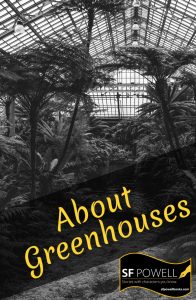A Look at Greenhouses
 It’s Plant a Vegetable Garden Day.
It’s Plant a Vegetable Garden Day.
In my novels, there’s plenty reference to plants and flowers, to gardens and gardening. A couple of my characters are nature-lovers. For book four, I’m interested in having a character own a greenhouse—where he/she will ‘hide’ from the world. Nature and garden parks are excellent hands-on resources for filling out the character profile for this, so …
A Place for All Seasons
The seasonality of plant varieties poses challenges to those growing plants continuously, regardless of season—rain or shine. This is especially true for flower and fruit varieties requiring sunlight all year, or for perennials that shrivel in winter.
The response to such seasonal challenges for gardeners is greenhouses. A greenhouse is a structure made of glass (or plastic). Generally, greenhouses protect climate sensitive plants from extreme shifts in temperature. They store the sun’s rays inside, simulating spring-like temperatures all year long. The stored heat inside a greenhouse allows gardeners to grow plants continuously even while winter rages. Greenhouses are also called glasshouses or hothouses.
It’s Always Greener … Inside a Greenhouse
A greenhouse, however, isn’t all about the sunshine. Maintaining one has its own share of work.
The outdoor environment establishes its own degree of balance to some extent as nature does its thing. A greenhouse, though, requires strictly regulating a controlled environment to simulate the outdoors—without overdoing it. Other factors to consider:
-
- water irrigation of the plants and ensuring there’s sufficient water available
- correct light exposure
- any presence of pests or diseases
Land position of the greenhouse is considered important, too. The southeast portion of the property is recommended because the minimal sunlight during the winter will be maximized by the greenhouse if in this location. In addition to simulating climate, also important is simulating natural activities like pollination. One way gardeners do this, is introducing insects that facilitate the process (e.g. bumblebees).
The Best ‘Greenhouse’ Effect
Greenhouses reduce the constraints of the seasons, uncooperative weather, and daylight vs. nighttime. They provide the option of gardening even at night because lighting and heat is constantly present inside the structure. Greenhouses also allow gardeners to plant exotic flowers and fruits usually grown in tropical areas. It’s like having the floral landscaping of the islands right in your backyard—all year long.
Greenhouses simply allow for the creation of a miniaturized and highly controlled natural environment to suit gardening needs. Its enhanced potential to grow fresh plants and produce even with the instability of global climate, proves beneficial well into the future.
And now, let me get back to fleshing out the few scenes I have in mind for one of my characters in book four. This whole greenhouse discussion has generated ideas for writing a couple plot points for the novel as well. The writing muse works so strangely sometimes. Gotta love him/her/it!
Until next time, stay serif.

